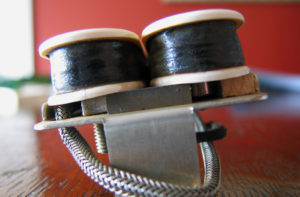Sourcing rare guitar parts
If specific parts have to be purchased to remedy an issue or a potential fault with a guitar I am setting up, then this will cost extra on top. I am able to source parts and can recommend some trusted people in the vintage guitar business, whom I often deal with directly, or I can refer you to straight to them if preferred.
Some vintage parts can be costly to buy, but to do so is absolutely necessary to preserve the originality of your guitar. Using eBay, Reverb and GBase, I have had to swallow hard at spending huge amounts on Pre-war Gibson rosewood bridges, 1950’s Gibson ABR-1 bridges, truss rod covers, period-correct screws and super-rare period tuners to put a few guitars back to 100% originality… Gibson’s, Gretsch’s and Fender’s all included.
A few years ago, it cost me close to £500 to buy and import an original circa 1960-1963 vintage lucite/perspex pick guard for a Gretsch White Falcon – with the sole intention of getting that guitar 100% vintage correct. Finally, one surfaced. This was after ten years of looking, emailing dealers and scouring eBay for an original one! None of the reissue pick guards would fit the original screw holes on the guitar. For years, that guitar had no pick guard and looked naked without one. The Gretsch White Falcon guard, as an artefact, is so flashy and iconic. It helps tie together the whole look of that particular guitar.
This, to me, is money well spent and of the utmost imperative, because for anybody who might need to sell an instrument further down the road, ‘originality’ is a key aspect to any potential buyer. Buyers are so much more particular nowadays. In the age of the internet, it’s relatively easy to profess to be an ‘armchair expert’. People have only to Google something specific to find out what something should look like. However, as the saying goes, don’t necessarily believe everything you see and read on the internet! Caveat Emptor – Buyer beware. Wider research is imperative, especially with more valuable instruments.
Vintage parts versus new parts; knowing the difference
I know, in great detail, about the history of vintage D’Angelico, Gibson, Gretsch and Fender guitars, their accompanying parts and how to identify them – from ALL true vintage, ‘golden-era’ years (1920-1970).
With so many reissue guitars around nowadays, a lot of companies manufacture similar looking, even accurate looking reissue parts. Unscrupulous sellers often try their luck at ‘hand-aging’ and re-selling these reissue parts at vintage parts prices. This is not uncommon! Anything to do with buying and selling vintage guitars and parts can be a minefield if you don’t know what you’re doing, or what you’re looking at. My keen eye, plus years of knowledge of what to look out for and various ‘tells’, could be a dealmaker or a dealbreaker to you as a buyer, or as a seller.
Not all sellers necessarily know what they’re selling either. Alternatively, some other sellers might not best describe the item they are selling. This may be down to many reasons; In order to mislead, withholding key information from their descriptions, or maybe they have just no clue at all. Sometimes, however, this can work out positively in the buyer’s favour!
